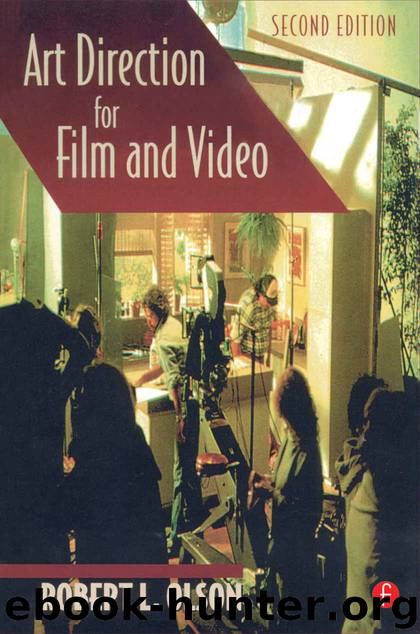Art Direction for Film and Video by Robert Olson

Author:Robert Olson
Language: eng
Format: azw3
ISBN: 9780240803388
Publisher: Taylor and Francis
Published: 1998-10-22T04:00:00+00:00
PATTY’S LIVING ROOM
After collecting and studying your research materials, you have an impression of Patty’s living room. Remember that a set is not a real room; it is just a collection of information based on what you know about the time period, the town, and how you visualize Patty’s character. Tell the audience that only Patty could live in this set – not her uncle or grandmother.
Give the room three-dimensional character for the camera so that it does not look like a painted theatrical backdrop. Set the windows and doorways in alcoves, use picture rails to give the walls character, and show logical changes in floor level. Don’t jam all the furniture against the walls, but group tables, chairs, and sofas out in the room, which will give the director and actors opportunities for action. Remember that all the furniture does not have to face the camera. Foreground pieces for the camera to look past enhance the real-room feeling.
The audience must sense that the rest of the house is there, but they just don’t see it. Provide open doors, which give the camera glimpses of other rooms that may exist only as a flat with a picture hanging on it.
How Big?
Cameras make sets look larger than they appear to the eye, so if you want a wall to look 10 feet wide, you might make the wall 9 feet wide. If unsure about room sizes, measure some familiar rooms for reference. When making sketches of sets, don’t worry too much about exact dimensions, but make your drawing represent the set in general size and feeling. When you have designed some sets and see them sitting grandly on stage, you will develop a sense of how sketch appearances compare to the result.
Remember that the producer and director, as well as other members of the company, will look at your preliminary sketches to get an impression of size, mood, and playing areas. When the producer tells you to make construction drawings, keep in mind what they have seen in the sketches so that you will not hear the dreaded words: “I didn’t know it was going to look like that!”
Perspective
To make the sketch look three-dimensional, you need to use a simple system of drawing called one-point perspective. Don’t be alarmed at that dreaded word; it’s just a mechanical device that will serve you well all the days of your design life. Tape the corners of an 18" x 24" piece of tracing paper to your drawing surface. If your sketch is smaller than 18" x 24", clients at production meetings will not be able to see it clearly from across the room. A reducing copying machine can make smaller versions of the sketch, which you can distribute at the meeting.
Download
This site does not store any files on its server. We only index and link to content provided by other sites. Please contact the content providers to delete copyright contents if any and email us, we'll remove relevant links or contents immediately.
Call Me by Your Name by André Aciman(20371)
Ready Player One by Cline Ernest(14524)
How to Be a Bawse: A Guide to Conquering Life by Lilly Singh(7391)
Wiseguy by Nicholas Pileggi(5671)
The Kite Runner by Khaled Hosseini(5083)
On Writing A Memoir of the Craft by Stephen King(4863)
Audition by Ryu Murakami(4850)
The Crown by Robert Lacey(4722)
Call me by your name by Andre Aciman(4619)
Gerald's Game by Stephen King(4581)
Harry Potter and the Cursed Child: The Journey by Harry Potter Theatrical Productions(4440)
Dialogue by Robert McKee(4321)
The Perils of Being Moderately Famous by Soha Ali Khan(4169)
Dynamic Alignment Through Imagery by Eric Franklin(4116)
Apollo 8 by Jeffrey Kluger(3637)
Seriously... I'm Kidding by Ellen DeGeneres(3577)
The Inner Game of Tennis by W. Timothy Gallwey(3575)
How to be Champion: My Autobiography by Sarah Millican(3555)
Darker by E L James(3477)
